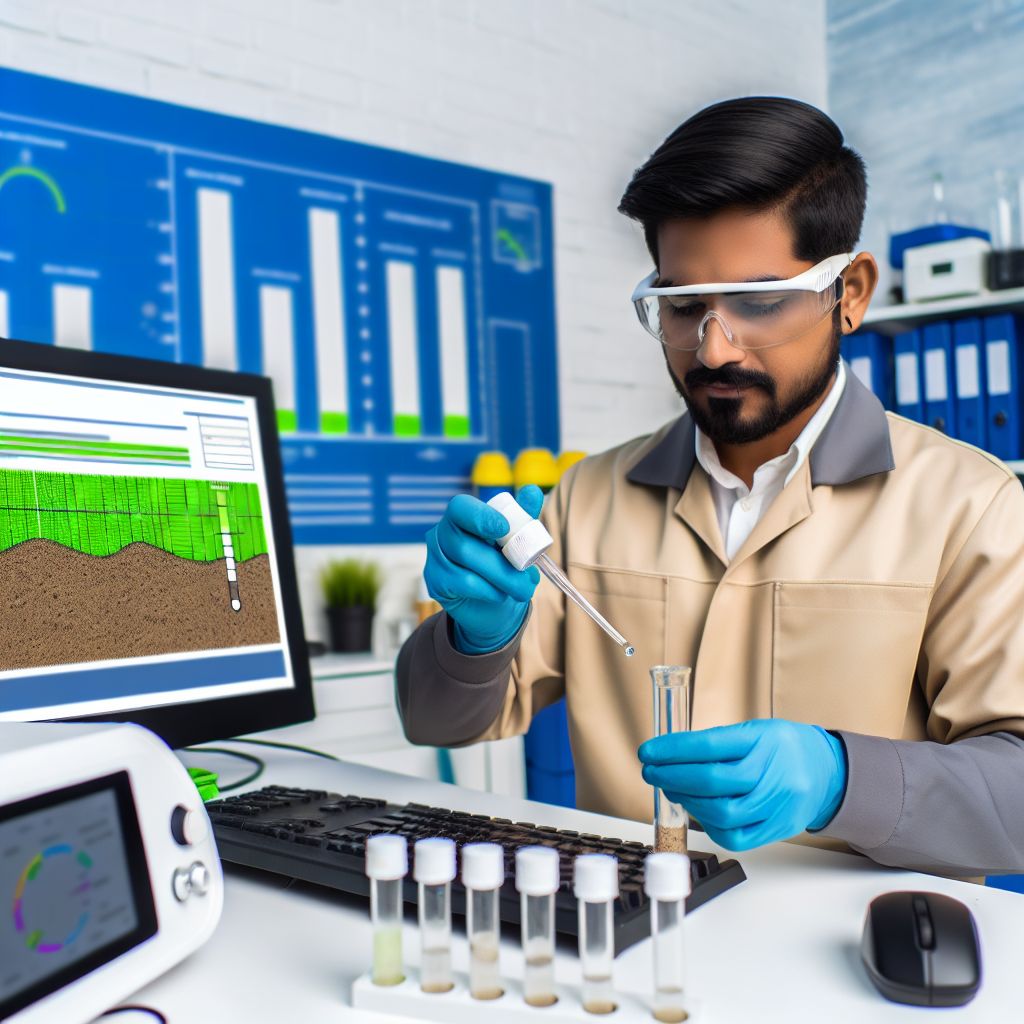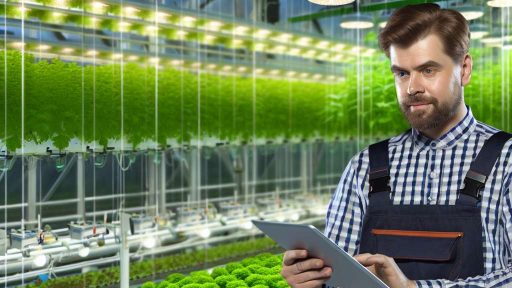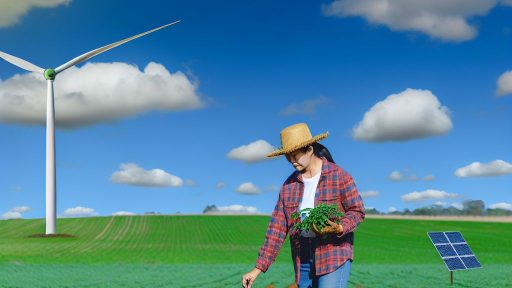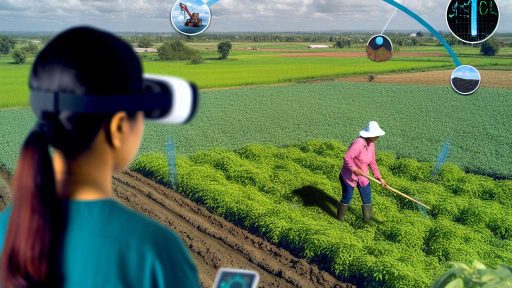Introduction to AI-Based Soil Health Analysis Tools
Soil health is crucial for sustainable agriculture.
Farmers aim to optimize crop yields while maintaining soil quality.
Recently, artificial intelligence has revolutionized soil health analysis.
These AI-based tools provide efficient and accurate soil assessments.
Benefits of AI in Soil Health Analysis
AI technology enables real-time data collection from soil samples.
Machines can analyze complex data faster than traditional methods.
As a result, farmers receive timely insights about soil conditions.
This proactive approach helps in better decision-making.
Key Tools and Technologies
Several innovative AI-based tools are available today.
- Remote sensing technology assesses soil moisture levels.
- Machine learning models predict nutrient needs for crops.
- Image recognition identifies soil types and health indicators.
These technologies work together to enhance soil management.
Implementation Challenges
Despite the benefits, challenges exist in adopting these technologies.
High initial costs can deter small-scale farmers from using AI tools.
Additionally, a lack of training can limit effective implementation.
Therefore, education on these tools is vital for success.
The Future of Soil Health Analysis
AI-based soil health analysis tools will continue to evolve.
Transform Your Agribusiness
Unlock your farm's potential with expert advice tailored to your needs. Get actionable steps that drive real results.
Get StartedAs technology improves, costs may decrease over time.
Moreover, collaboration between tech companies and farmers is essential.
This partnership will drive innovation and adoption rates.
Ultimately, healthier soil can lead to sustainable food production.
Benefits of Using AI in Soil Health Assessment
Enhancing Accuracy and Precision
AI tools significantly enhance the accuracy of soil health assessments.
These technologies analyze soil characteristics with high precision.
Moreover, they reduce human error in data collection.
Increasing Efficiency in Data Collection
AI accelerates the process of gathering soil data.
Automated systems can collect samples faster than traditional methods.
As a result, farmers can make quicker decisions.
Providing Real-Time Insights
AI-driven systems offer real-time data analysis.
This capability leads to timely interventions in farming practices.
Farmers can adjust their strategies based on immediate soil conditions.
Facilitating Predictive Analysis
AI can predict future soil health trends effectively.
Through data modeling, farmers can anticipate changes in soil composition.
Consequently, they can prepare for potential issues proactively.
Cost Savings for Farmers
Implementing AI tools can lead to significant cost savings.
By optimizing resource use, farmers reduce unnecessary expenditures.
This efficiency translates to better profit margins overall.
Supporting Sustainable Farming Practices
AI contributes to sustainable agriculture by promoting soil health.
It helps minimize chemical usage through precise application forecasts.
Ultimately, this leads to healthier ecosystems and productive farms.
Types of AI Algorithms Used in Soil Analysis
Machine Learning Algorithms
Machine learning algorithms are foundational in soil analysis.
These algorithms learn from data patterns to make predictions.
Showcase Your Farming Business
Publish your professional farming services profile on our blog for a one-time fee of $200 and reach a dedicated audience of farmers and agribusiness owners.
Publish Your ProfileCommon techniques include decision trees and support vector machines.
Decision trees help classify soil types based on specific features.
Support vector machines effectively handle complex datasets.
Moreover, random forests enhance prediction accuracy by combining multiple trees.
Deep Learning Approaches
Deep learning approaches are increasingly popular in soil health analysis.
These methods utilize neural networks to process large datasets.
Convolutional neural networks excel in image recognition tasks.
They analyze soil images to identify various soil characteristics.
Recurrent neural networks can capture temporal changes in soil health.
This is important for assessing seasonal variations in soil properties.
Statistical Methods
Statistical methods play a crucial role in soil analysis.
Regression analysis predicts soil characteristics based on other variables.
It helps in understanding soil behavior under different conditions.
PCA, or principal component analysis, reduces dimensionality in data.
This simplifies the analysis by focusing on key soil properties.
Ensemble Learning Techniques
Ensemble learning techniques combine multiple models for better predictions.
They improve the robustness of soil analysis outcomes.
Bagging is one such technique that reduces variance in predictions.
Boosting, on the other hand, focuses on correcting errors from previous models.
These techniques are highly effective in complex soil datasets.
Support Vector Machines
Support vector machines are particularly useful for classification tasks.
They identify the optimal hyperplane that separates different soil types.
This helps in precise soil categorization based on features.
Moreover, these algorithms are effective in high-dimensional spaces.
Thus, they provide accurate results even with limited training data.
Find Out More: Smart Farming Solutions Through Controlled Environment Agriculture
Case Studies: Successful Implementations of AI Soil Health Tools
Introduction to Case Studies
AI-based soil health analysis tools have transformed agricultural practices worldwide.
Many farmers now leverage these tools for better productivity.
In this section, we explore various successful implementations.
Case Study: GreenField AgriTech
GreenField AgriTech developed an AI-powered soil assessment tool.
This tool analyzes soil data in real-time.
Farmers use it to optimize fertilizer application.
As a result, GreenField reported a 20% increase in crop yields.
Key Features of the Tool
- Real-time soil moisture monitoring.
- Automated nutrient recommendations.
- User-friendly mobile application interface.
Impact on Farmers
Farmers experienced reduced costs on fertilizers.
Additionally, they saved time on manual soil testing.
Satisfaction improved among the users.
Case Study: EcoSoil Solutions
EcoSoil Solutions introduced an AI diagnostic platform.
This platform helps identify soil health issues early.
Farmers receive detailed reports tailored to their fields.
Consequently, EcoSoil saw a significant reduction in crop loss.
Showcase Your Farming Business
Publish your professional farming services profile on our blog for a one-time fee of $200 and reach a dedicated audience of farmers and agribusiness owners.
Publish Your ProfileTechnology Utilized
- Machine learning algorithms for data analysis.
- Integration with satellite imagery for field assessments.
- Cloud-based storage for easy access to insights.
User Experiences
Testimonials from farmers highlight increased confidence in decision-making.
Many report healthier crops as a direct result of using the platform.
Case Study: AgriBot Innovations
AgriBot Innovations created a soil health robot.
This robot performs on-site soil testing autonomously.
Using AI, it generates comprehensive soil health reports.
Farmers have noted significant improvements in soil management practices.
Robot Capabilities
- Real-time data collection throughout the growing season.
- Recommendations for cover cropping and soil amendments.
- Regular updates on soil pH and nutrient levels.
Benefits to Local Farming Communities
Local communities have embraced the technology.
Education programs on tool use further increase adoption.
This innovation fosters collaboration among farmers.
Implications of AI in Soil Health Analysis
These case studies demonstrate the effectiveness of AI in analyzing soil health.
Farmers actively improve their practices through technology.
As more tools become available, the future of agriculture looks promising.
You Might Also Like: Blockchain Technology Improving Supply Chain Transparency For Farmers
Challenges and Limitations of AI in Soil Analysis
Data Quality and Availability
The effectiveness of AI tools relies heavily on data quality.
Inadequate or inaccurate data can lead to misleading results.
Additionally, data availability varies significantly across regions.
Many rural areas lack the necessary soil data for effective analysis.
Complex Interactions in Soil Chemistry
Soil chemistry involves complex interactions that are not fully understood.
AI models may struggle to capture these intricate relationships.
As a result, predictions can be overly simplistic or erroneous.
Need for Expert Knowledge
Implementing AI effectively requires expertise in both agriculture and technology.
Many farmers may lack the necessary knowledge to use AI tools competently.
This gap may lead to underutilization or misuse of these technologies.
Regulatory and Ethical Considerations
The integration of AI in agriculture raises regulatory challenges.
There may be concerns regarding data privacy and ownership.
Additionally, ethical considerations must guide AI development and use.
Limitations of AI Algorithms
While AI algorithms can analyze patterns, they have limitations.
For example, algorithms may not account for rare events or anomalies.
This limitation can affect the reliability of predictions.
High Initial Costs
Implementing AI soil analysis tools often involves high initial costs.
Many small-scale farmers may find such investments prohibitive.
This cost barrier can hinder widespread adoption of technology.
Resistance to Technological Change
Resistance to change is a significant challenge in adopting AI tools.
Some farmers may trust traditional methods over new technology.
Overcoming this mindset requires robust education and outreach efforts.
Find Out More: Integrating Biotechnology With Traditional Farming Methods

Future Trends in AI-Driven Soil Health Technologies
Advancements in Data Collection
New technologies enhance data collection methods for soil health analysis.
Drones equipped with sensors can rapidly assess large areas.
Additionally, IoT devices collect real-time data on soil conditions.
These advancements offer farmers more precise and actionable insights.
Showcase Your Farming Business
Publish your professional farming services profile on our blog for a one-time fee of $200 and reach a dedicated audience of farmers and agribusiness owners.
Publish Your ProfileIntegration of Machine Learning
Machine learning models analyze complex data sets effectively.
They improve predictions regarding soil health trends over time.
Moreover, these models can tailor recommendations for specific crops.
Farmers benefit from increased accuracy in their soil management strategies.
Use of Predictive Analytics
Predictive analytics tools forecast soil health outcomes based on historical data.
These insights allow farmers to make proactive decisions.
Consequently, they can optimize fertilization and irrigation practices.
This approach supports sustainable farming and resource efficiency.
Enhanced User Interfaces
Future tools will likely feature user-friendly interfaces.
These interfaces simplify complex data interpretation for farmers.
As a result, more agriculturalists can access and utilize soil health data.
Enhanced usability fosters broader adoption of AI technologies in agriculture.
Collaboration Across Sectors
Future trends emphasize collaboration between tech companies and farmers.
Such partnerships accelerate the development of tailored solutions.
They combine agricultural expertise with technological innovation effectively.
This synergy boosts soil health management practices significantly.
Focus on Sustainability
Upcoming technologies will prioritize sustainable practices in agriculture.
They encourage soil conservation and biodiversity maintenance.
Through AI, farmers can adopt environmentally friendly methods easily.
This trend aligns with global goals for sustainable development.
Explore Further: Implementing Drone Technology On Modern Farms
Integration of AI Soil Analyzers with Precision Agriculture
Understanding AI Soil Analyzers
AI soil analyzers use artificial intelligence to assess soil health.
These tools analyze key soil properties quickly and accurately.
They collect data on pH, nutrient levels, and organic matter content.
Using advanced algorithms, they interpret complex data sets efficiently.
Farmers benefit from real-time insights into soil conditions.
Benefits of Integrating AI in Precision Agriculture
Integrating AI with precision agriculture enhances decision-making.
This technology helps optimize resource usage on farms.
Farmers can apply fertilizers and irrigation more effectively.
As a result, crop yields increase while minimizing waste.
Moreover, it reduces the environmental impact of farming practices.
Case Studies of Successful Integration
Various farms have successfully integrated AI soil analyzers.
One example is Green Fields Agronomy in California.
They increased their yield by 25% after adopting AI tools.
Similarly, Sunny Acres Farm in Texas improved soil health significantly.
Both cases highlight the effectiveness of AI in practical applications.
Challenges and Considerations
Adopting AI soil analysis tools presents some challenges.
Farmers must invest in technology and training programs.
Data management and interpretation can also be complex.
Additionally, ensuring accurate calibration of devices is crucial.
Showcase Your Farming Business
Publish your professional farming services profile on our blog for a one-time fee of $200 and reach a dedicated audience of farmers and agribusiness owners.
Publish Your ProfileHowever, addressing these challenges leads to better long-term outcomes.
The Future of AI in Agriculture
The future of AI in agriculture looks promising and innovative.
As technology advances, tools will become even more sophisticated.
Farmers will have access to predictive analytics for their crops.
Integrating AI with IoT devices will offer seamless data collection.
Ultimately, this leads to sustainable farming practices worldwide.
Comparative Analysis of Traditional Soil Testing vs AI Tools
Understanding Traditional Soil Testing
Traditional soil testing has been a cornerstone of agricultural practices for decades.
Farmers typically collect soil samples from different locations.
These samples undergo laboratory analysis for various parameters.
Common tests evaluate pH, nutrient levels, and organic matter.
Results often take several days to process.
Farmers rely on this data to inform their management decisions.
Limitations of Traditional Testing
However, traditional methods present some challenges.
Sampling can be labor-intensive and time-consuming.
Weather conditions may affect soil sampling accuracy.
Moreover, results can become outdated quickly.
Farmers may miss rapid changes in soil health.
These delays impact timely decision-making in the field.
Introduction to AI-Based Soil Health Tools
In contrast, AI-based soil health analysis tools offer innovative solutions.
These tools analyze soil data in real-time, enhancing efficiency.
AI algorithms process large datasets, identifying patterns quickly.
Farmers receive immediate insights, allowing for prompt actions.
These tools integrate various data sources, improving accuracy.
Benefits of AI Tools
- They provide instant feedback, allowing for quicker decision-making.
- Farmers can understand soil health trends more dynamically.
- AI can predict future soil conditions using historical data.
- These tools are less labor-intensive, saving time and resources.
Evaluation of Accuracy and Cost
When comparing accuracy, AI tools often outperform traditional testing.
They reduce human error and enhance data interpretation.
Moreover, AI tools can lower overall costs by minimizing wastage.
Farmers invest in these tools for long-term savings and sustainability.
Integrating Traditional and AI Methods
While AI tools show promise, traditional methods still hold value.
Farmers can benefit by integrating both approaches.
Combining reliable lab tests with AI insights may offer the best results.
This hybrid approach leverages the strengths of both methods.
Ultimately, a comprehensive understanding of soil health emerges.
Additional Resources
Conservation Innovation Grants Awards Fiscal Year 2023 | Natural …




